Vintage Ads: Popular Presents from the 1900s
In 1900, a fortnight meant two weeks and a talking machine didn’t involve Alexa. Gifts – and the advertisements for them – have changed a lot since then. Here’s a look back at advertisements for some of the most popular gifts of the 1900s.
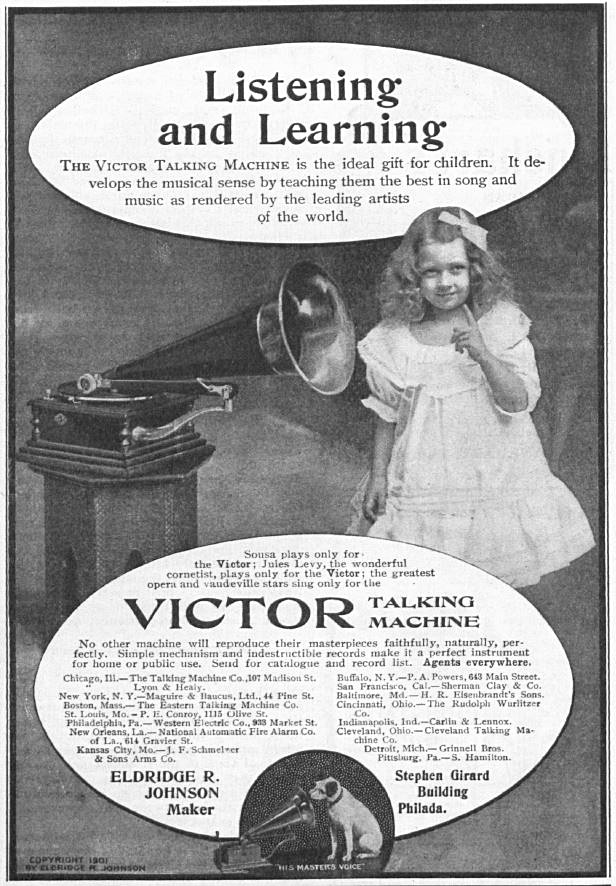
December 7, 1901
This ad appeared shortly after the Victor Talking Machine Company was incorporated. The more familiar “Victrola” brand was introduced five years later, in 1906, and was the most popular home phonograph brand for decades.
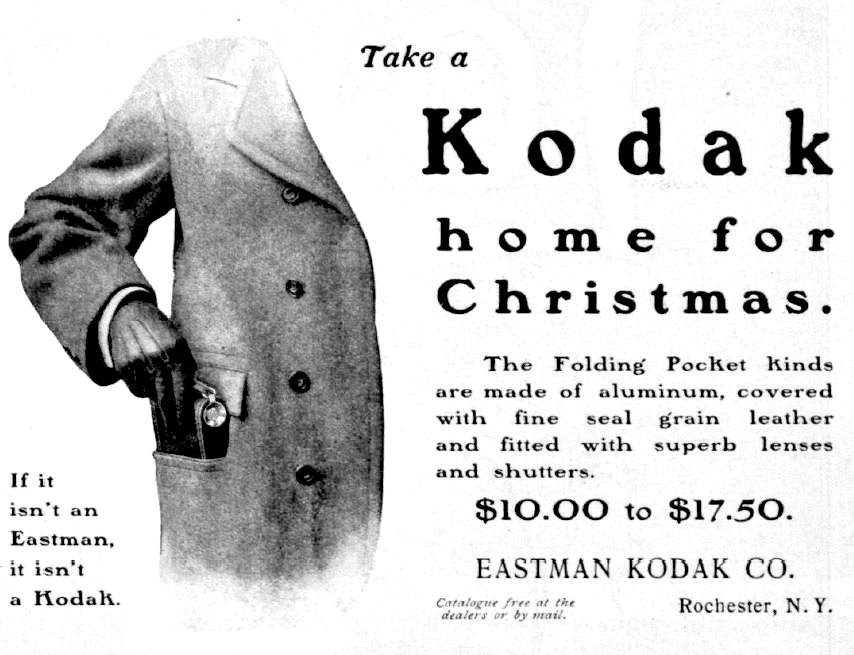
December 8, 1900
In 1898, Kodak started selling the Folding Pocket Camera, the ancestor of all modern roll-film cameras. This camera also introduced the 2¼” x 3¼” picture size, which proved very popular.
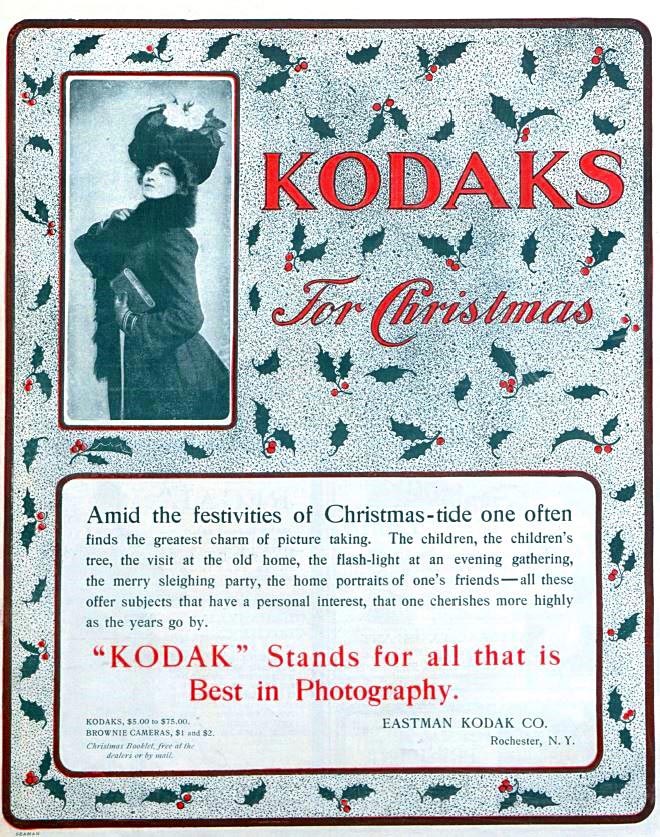
December 7, 1901
Kodak cameras, which had been created by George Eastman in 1888, had just released its lower-priced Brownie model the year before this ad appeared. The Brownie created a new mass market for photography, and 1901 was one of the first Christmas seasons that put a camera within almost everyone’s reach.

December 7, 1901
R.F. Simmons Company was founded in 1873 in Attleboro, Massachusetts. Simmons claimed to be the first jeweler to issue a chain catalogue, the first to stamp jewelry with the manufacturer’s initials, the first to offer a satisfaction guarantee, and the first to use a safety fastener.
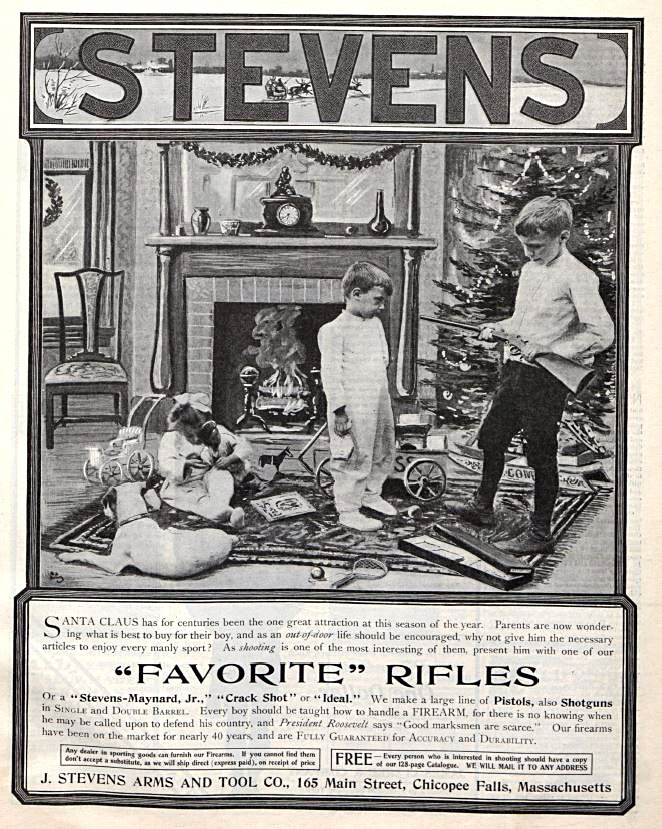
December 6, 1902
In the early 20th century, Stevens was one of the largest firearms manufacturers in the United States. The company was purchased by New England Westinghouse, specifically to provide rifles to the Russian Czar and his army during World War I. After the Czar fell and the bill went unpaid, the company fell into financial distress. Despite a few rough patches, the company continues to make firearms under the Stevens name today.
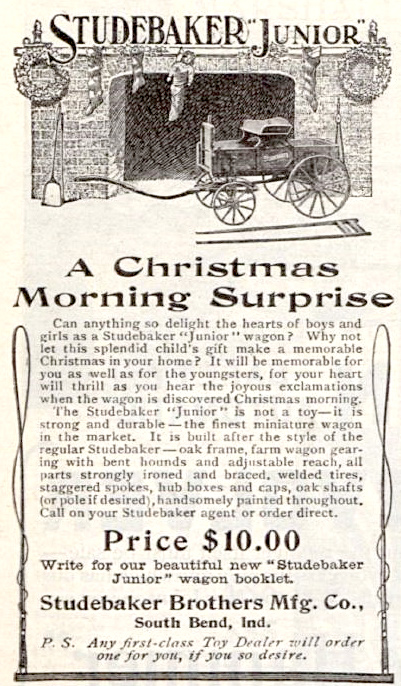
December 2, 1905
This child-size version of the Studebaker farm wagon was a popular (and pricey) toy in the early 20th century. Studebaker debuted its first automobile a year later.
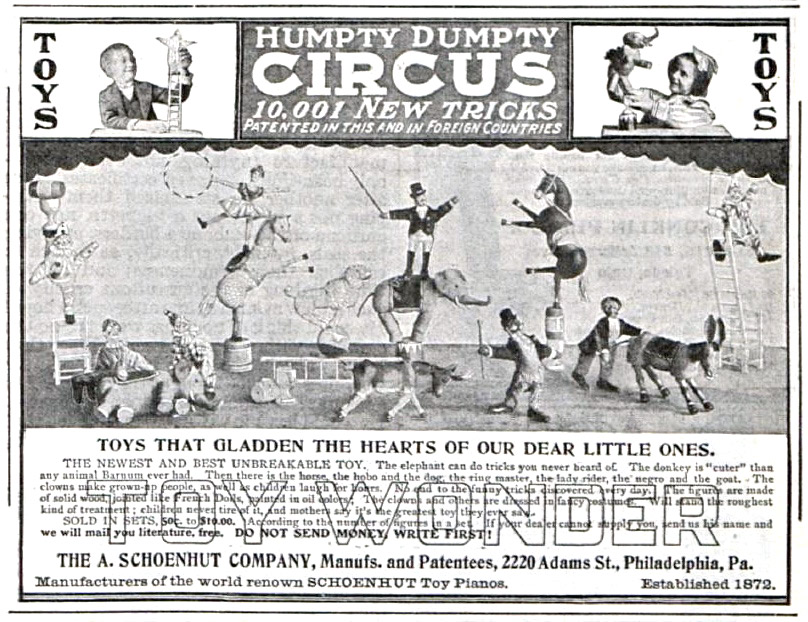
December 2, 1905
The Philadelphia-based A. Schoenhut Company sold this popular circus set from 1903 to 1935. Early versions such as this one featured animals with glass eyes and real hair. The figures had articulated limbs held together with elastic bands that allowed them to be posed in different positions. By 1912, Schoenhut was the largest toy company in the United States.
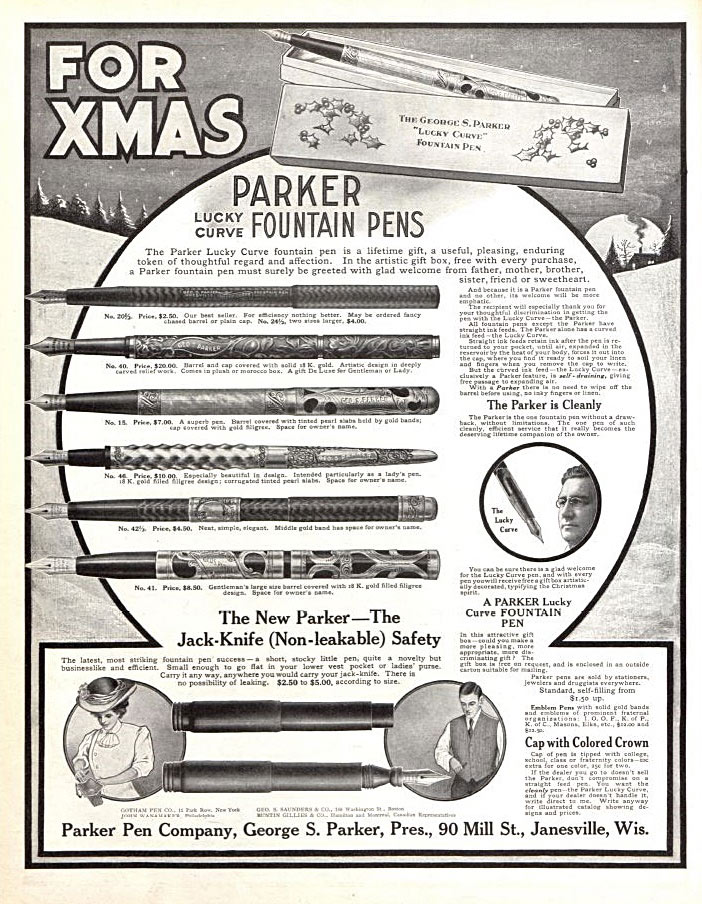
December 4, 1909
Parker Pens was founded in 1888 and continues to produce writing instruments today, although fountain pens have fallen out of favor with all except the most tradition-bound. The pens in this advertisement are worth considerably more today, and can sell for upwards of several thousand dollars.
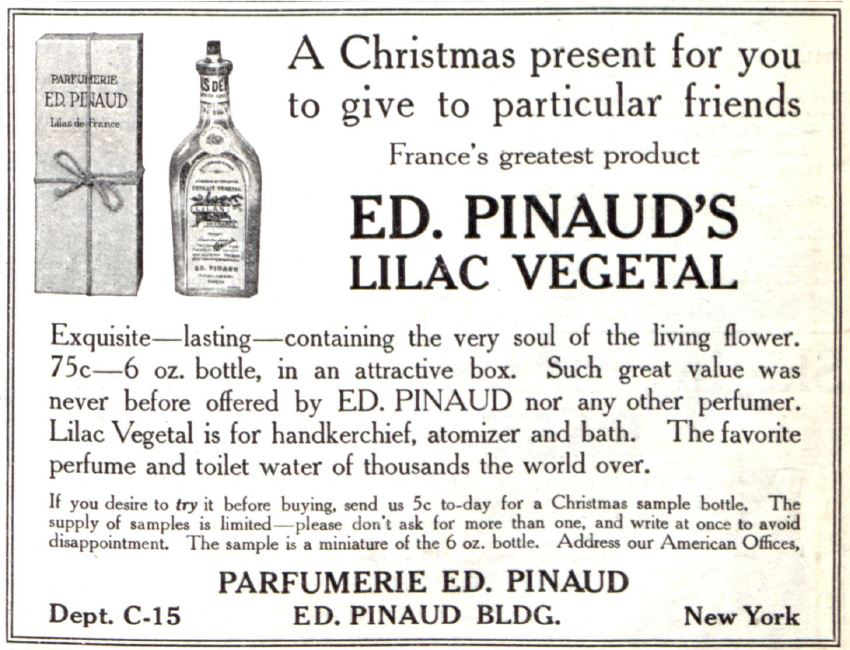
December 4, 1909
Perfume has always been a traditional gift, but this one has a unique twist. Edouard Penaud ostensibly created Lilac Vegetal as an aftershave for the Hungarian cavalry.
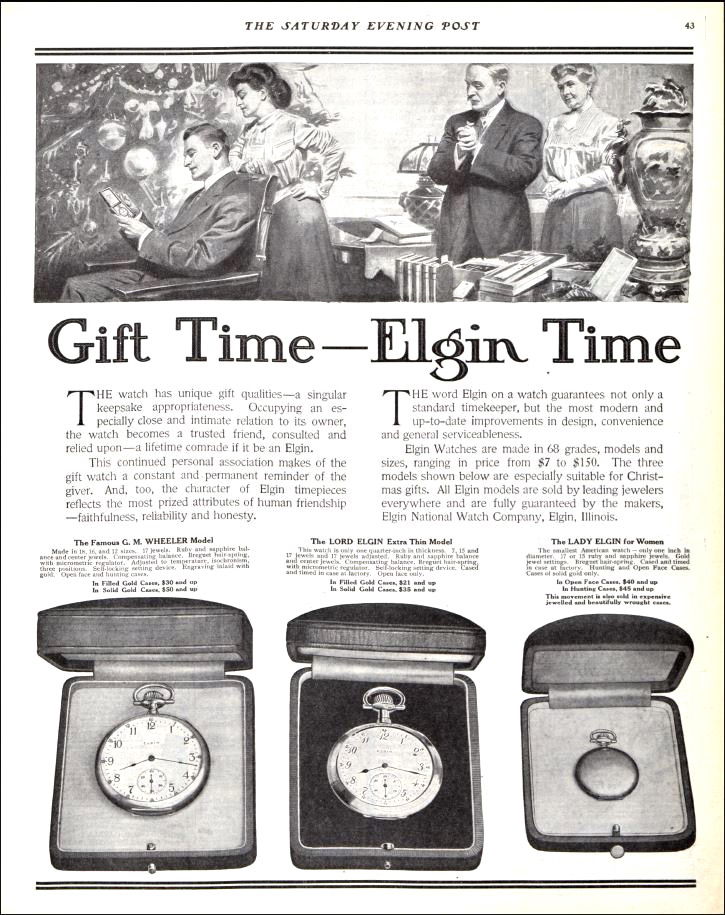
December 4, 1909
Elgin National Watch Company produced watches for 100 years, manufacturing more than 60 million of them between 1864 and 1968. Pocket watches were the standard timepiece in 1909. Elgin was one of the first companies to make a wristwatch, which they started selling a year later.
News of the Week: Rockers Snubbed, the Grinch Arrested, and Chestnuts Roasting, Well, Everywhere
2018 Rock & Roll Hall of Fame Inductees
Of course, I mean the year 2018. It would be really weird if the Rock & Roll Hall of Fame inducted that many musicians in a single year.
The inductees this time around are Dire Straits, The Moody Blues, The Cars, Bon Jovi, Nina Simone, and Sister Rosetta Tharpe. All fine choices, I guess (don’t get me started on Bon Jovi), but it means that a lot of people didn’t make it again this year (musicians are eligible 25 years after the release of their first commercial recording), including Depeche Mode, Judas Priest, Eurythmics, the Zombies, Janet Jackson, Devo, New Order, Iron Maiden, Roxy Music, the Cure, Tina Turner, and the Smiths.
I would also add Marshall Crenshaw to that list. I don’t know if he’ll ever be nominated but he deserves to be there.
Stink, Stank, Stunk!
This is a great story. It involves a five-year-old boy from Jackson, Mississippi, who called 911. Why did he call? Because he was upset that the Grinch was going to steal Christmas.
The father got on the phone to assure the 911 operator that there was no problem. The police went to the house to check on things anyway, and the boy showed them a YouTube clip of the Grinch and what he had planned. The police assured him that they weren’t going to let the green guy steal anything, and to prove it, they invited the boy to the police station two nights later so he could actually lock up the Grinch in a cell.
Of course, now the family has to make sure the boy doesn’t watch The Grinch Who Stole Christmas again, or he may think the Grinch escaped. Or at least let him watch it until the end, when his heart grows bigger as he learns the true meaning of the holiday and gives all the gifts back.
It’s the Most Wonderful, Annoying Words of the Year
Every December, magazines, newspapers, and websites release their best-and-worst lists for the year. The best and worst movies, the best and worst albums, the best and worst political stories of the year. It’s a year-end tradition we look forward to as much as stuffing and the first snow.
I don’t know if this counts as a “best” or a “worst” — maybe it’s the best of the worst — but the list of the most annoying words of 2017 has been released by Marist College. For the ninth year in a row, Americans have declared the word whatever the “winner.”
Other annoying words and phrases of the year include fake news; literally; you know what I mean; ya know, right; and huge. Actually, I would add the words actually, like, irregardless, basically, selfie, hashtag, and viral.
Maybe Marist should declare that whatever can no longer be named an annoying word of the year. It’s won way too many years. It’s the Modern Family of annoying words and should take itself out of consideration.
New Raymond Chandler
Raymond Chandler is one of my favorite writers, so when I heard that there was a newly discovered short story about to be published, I was more excited than a salad in a paper towel factory (I have no idea what that even means, that’s how excited I am). The story is in the current issue of The Strand, and it’s titled “It’s All Right — He Only Died.”
From that title, you might be expecting a two-fisted Philip Marlowe detective tale, but it’s actually about … the U.S. healthcare system? That’s right, Chandler was thinking about that way back in the 1950s (he died in 1959). Luckily, in the six decades since the story was written, we’ve completely solved any problems we may have had with healthcare.
Last-Minute Gift Idea
Did you know that Christmas is this Monday? That means you only have this weekend to buy the rest of your gifts, unless you’re one of those people who goes to CVS on Christmas morning and grabs a box of chocolate or whatever perfume is on sale.
May I suggest something that can be enjoyed the entire year, something that’s like getting a new Christmas gift every other month? A subscription to The Saturday Evening Post! Right now you can get an entire year (six issues) for a savings of up to 49 percent. With that subscription, you also get discounts on car rentals, travel, entertainment, even insurance! It’s a great deal and a great magazine (and I’d say that even if I didn’t work here).
RIP Keely Smith
Keely Smith was an acclaimed singer known for her partnership with husband and bandleader Louis Prima. She is remembered for such songs as “I Wish You Love,” “That Old Black Magic,” and “I’ve Got You Under My Skin.” She died Saturday at the age of 89.
Here’s her version of “I’ll Be Home for Christmas.”
The Best and the Worst
Best: My favorite things this week haven’t even happened yet. They’re on TV tonight. CBS is continuing its annual tradition of showing back-to-back classic episodes of I Love Lucy and The Dick Van Dyke Show. It all starts at 8 p.m.
Worst: This also involves CBS’s airing of I Love Lucy and The Dick Van Dyke Show. As I mentioned just four seconds ago, it’s great that they air these episodes every Christmas. But do they have to be colorized? And do they have to be the edited versions of the episodes? That’s a travesty (the latter more than the former). These shows were both originally on CBS, so I don’t know why they have to show edited versions. And as for colorizing them, that was interesting the first time as a little historical pop culture curio, but colorizing TV shows and movies rarely works (the colorized Miracle on 34th Street I watched the other night looked awful). Really, viewers can handle black and white.
This Week in History
Wright Brothers Take Off (December 17, 1903)
Here’s an interview the Post did with Orville Wright in 1928 on the 25th anniversary of the historic flight.
A Christmas Carol Published (December 19, 1843)
The classic Charles Dickens novella has been filmed a gazillion times and the basic plot has been used in countless stories and TV shows. The first film made from the story was a 1901 short silent film titled Scrooge, or, Marley’s Ghost.
If you really enjoy the story, you could start a collection of various editions. This guy did, and he’s up to 1,000 of them.
This Week in Saturday Evening Post History: Centering the Christmas Tree (December 22, 1951)
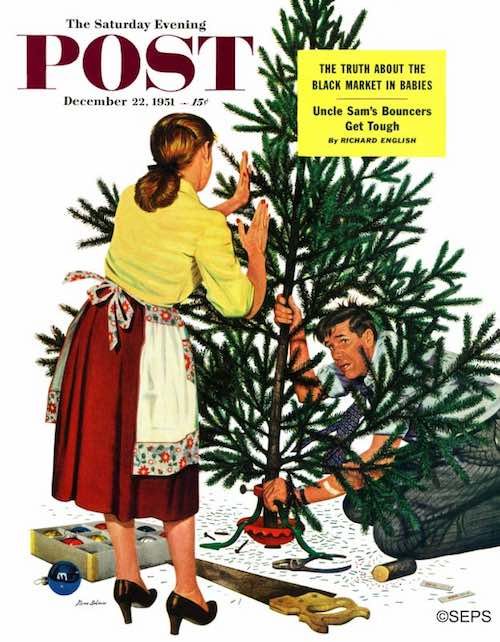
Stevan Dohanos
December 22, 1951
Remember I told you a couple of weeks ago that I like artificial Christmas trees because they don’t shed like real trees? Look at this cover by Stevan Dohanos. Just look at it! Pine needles all over the place.
Christmas Recipes
I was listening to “The Christmas Song” the other day — I’ve already heard it 100 times this month — and realized that it’s been 30 years since I’ve had chestnuts roasting on an open fire. Actually, I’ve never had chestnuts roasting on an open fire. My mom used to boil them.
But it did get me thinking about the foods that are mentioned in Christmas songs, so I thought I’d list some recipes for you to make this holiday season. Here are five vintage and delicious recipes for chestnuts, and if you enjoy “We Wish You a Merry Christmas,” here’s a recipe for figgy pudding. Brenda Lee sang about pumpkin pie in “Rockin’ Around the Christmas Tree,” and if you’re a “Grandma Got Run Over by a Reindeer” fan, here’s an eggnog recipe from Alton Brown (please note that it includes bourbon). And don’t forget, it’s a marshmallow world that we live in.
Merry Christmas!
Next Week’s Holidays and Events
Boxing Day (December 26)
The holiday started in Britain in the 1830s as a day to honor “post-men, errand-boys, and servants of various kinds.”
National Fruitcake Day (December 27)
Also known as “The Day Everyone Throws Away the Fruitcake They Got for Christmas” Day.
News of the Week: Words of the Year, Why We Say ‘Um,’ and (Literally) Half-Off Christmas Trees
And the Word of the Year Is…
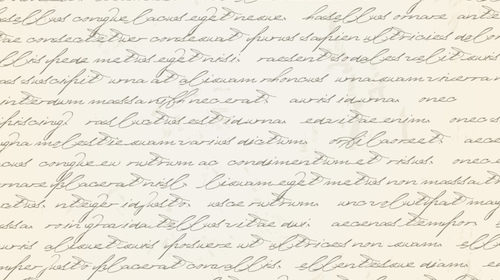
This week Merriam-Webster announced their “Word of the Year,” and it’s pickles. I know, I’m stunned too!
Okay, the word is actually feminism. I don’t have to explain why that is the biggest word of 2017, but you can read more about it at Merriam-Webster’s site. And it’s not the only important word chosen by the venerable language company. Other words of the year include complicit, recuse, empathy, dotard, and … gyro? I don’t remember that being a big word this year; apparently Jimmy Fallon did a gyro-based comedy sketch with country singer Luke Bryan and suddenly everyone was talking about gyros, I guess.
Part of the reason the words were chosen is because they’re the words people searched for the most during the year after hearing them in the news, online, and in pop culture.
I still think pickles will be big in 2018. You can put them in a gyro.
As Judge Judy Says, Um Is Not an Answer
We have, um, a lot of verbal tics that we often say. They’re, um, a way of thinking of what we want to say, sort of a verbal, um, placeholder. A lot of people think that it’s, um, better than stopping for a second and saying, um, nothing.
Isn’t it annoying when the ums we say are written out like that? Of course! I often wonder why people don’t fight harder to stop using the word (if we can even call it a word). I’ve done it myself in the past, though it’s really a bad habit we should try to break. But why do people do it? This article at The Atlantic attempts to explain it. Writer Julie Beck talks to N.J. Enfield, a professor and author of the book How We Talk. He actually sees some use in um. He calls it a “hesitation marker,” and it can be useful in conversation.
I guess it could be worse. I was once in a coffee shop and overheard a job interview at the next table. The interviewee must have said “like” 100 times in the span of five minutes.
To the Moon (and Mars), Alice!
First off, I hope you got that reference.
Second, as someone who has been a space geek since he was a kid, I think this is exciting news. President Trump signed a directive this week that will “refocus America’s space program on human exploration and discovery.” With former astronaut Harrison Schmitt at his side, the president announced new projects to send humans back to the moon and eventually to Mars. It’s called “Space Policy Directive – 1,” which isn’t the most romantic name, but it does have a certain Star Trek feel about it.
Facebook Is Bad, Say People Who Helped Create Facebook

A billion people use Facebook, but a lot of them are getting tired of it. Some have cut down on the number of times they post or even check it, and some have deleted their accounts altogether. It’s probably always going to be popular, but you’re starting to hear more and more people fighting against its influence and pull.
But you rarely hear those things from people who actually had a hand in it becoming the online force that it is. The past couple of weeks, we’ve heard from two different former Facebook honchos who say that maybe Facebook (and social media in general) isn’t worth it. Former Facebook President Sean Parker says, “I don’t know if I really understood the consequences of what I was saying, because of the unintended consequences of a network when it grows to a billion or two billion people and it literally changes your relationship with society, with each other … God only knows what it’s doing to our children’s brains.”
Former Vice President of User Growth Chamath Palihapitiya was even more blunt, saying, “I think we have created tools that are ripping apart the social fabric of how society works.” He says he feels “tremendous guilt” about what he has done. Facebook has actually responded to the criticism.
Maybe you should deactivate your Facebook account and see how it goes? Make it a New Year’s resolution. Who knows, you might even like not being connected to everyone and everything all the time.
But wait a couple of weeks before you do it, because I want you to head over to our Facebook page and share this column with your friends.
O Christmas Half-Tree, O Christmas Half-Tree

Last week I brought up the “real vs. artificial Christmas tree” debate, and from what I heard from readers, a lot of people like real and a lot of people like artificial, with maybe a slight edge to the real tree crowd. The other day, a supermarket cashier went on and on to me about the virtues of a real tree. I didn’t feel like getting into a discussion with her about why I like artificial trees (plus my ice cream was melting).
But what if real or fake isn’t the problem you face? Maybe it’s space. That’s where this Christmas half-tree comes in. It’s a tree that’s sliced down the middle, so it lies flush with the wall. It’s artificial, and stores in Britain are selling it for around $130.
If you really have no room, you can put your Christmas tree directly on the wall.
The Best and the Worst
Best: A new holiday tune from Dick Van Dyke and Jane Lynch, “We’re Going Caroling.” Van Dyke turned 92 on Wednesday, and he’s twice as active as I am.
Worst: This Slate article that dumps on Hallmark Channel Christmas movies. Now, feel free to critique the movies for how they’re made or the plots or the dialogue or the fact that it seems like 400 new ones are pumped out every year (I find them oddly comforting), but the author of the piece makes the whole discussion political and sour, as if we need any more of that.
This Week in History
Frank Sinatra Born (December 12, 1915)
Ol’ Blue Eyes would have turned 102 this week. There’s a new Sinatra holiday album titled Ultimate Christmas, and it includes this song, written in 1954 by Sammy Cahn and Jule Styne. According to Sinatra’s daughter Nancy, Frank wanted a new Christmas song that would be his, and Cahn and Styne came up with “The Christmas Waltz.” It was the B-side to “White Christmas.”
Bill of Rights Ratified (December 15, 1791)
The first ten amendments to the Constitution were created in 1789 and ratified two years later. President Roosevelt declared December 15 Bill of Rights Day in 1941.
This Week in Saturday Evening Post History: Christmas Train Set (December 15, 1956)
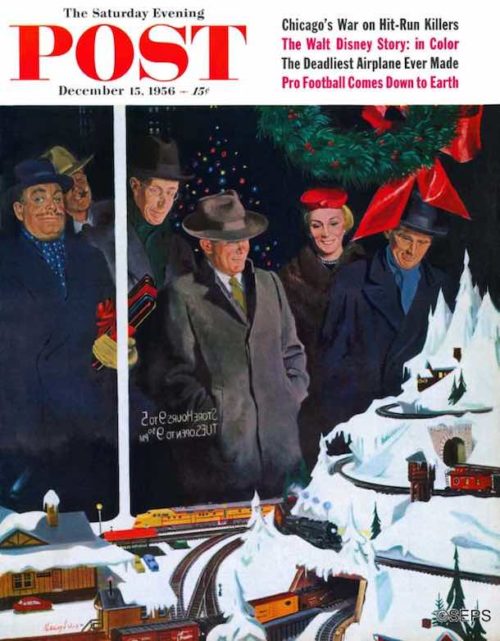
December 15, 1956
George Hughes
Do kids still get train sets for Christmas, or is there now an app for that? I don’t know, but my favorite thing about this cover by George Hughes is the guy on the left. He seems to be looking directly at the artist and thinking, “Yeah, draw me, whatever.”
Today Is National Cupcake Day

Remember three or four years ago when cupcakes were the hottest thing? Cupcake shops popped up everywhere, and it seemed like every food show on television revolved around cupcakes. Then they just faded away, replaced by kale and fidget spinners and HQ Trivia.
Good Housekeeping has 28 Christmas-oriented cupcakes you can make for National Cupcake Day, including ones that look like snowballs, reindeer, Christmas trees, Santa hats, and even Ebenezer Scrooge. If you’re feeling like the actual Ebenezer Scrooge and don’t want cupcakes that remind you of Christmas, try these Oreo Cupcakes.
Hey, you know what you should do on Christmas morning? Fill your kids’ stockings with kale. The joy on their faces will be priceless, and you can post the pictures to Facebook.
Next Week’s Holidays and Events
Winter Begins (December 21)
The Winter Solstice for the Northern Hemisphere begins at 11:28 a.m. EST. There’s also something called a “Meteorological Winter” and that began December 1, but that’s just confusing, so forget I even mentioned it.
Crossword Puzzle Day (December 21)
This marks the day in 1913 that the first official crossword puzzle was published. You can try to solve it at the American Crossword Puzzle Tournament site. I couldn’t finish it.
Let’s Have a Post-Christmas Vent Day
Last Christmas Eve, my wife sent me to the local supermarket to pick up something she’d forgotten to buy. The parking lot had one empty space, but I was in the holiday spirit, so signaled a woman to take it. She saw me in the dairy aisle and stopped to thank me for being so kind. I told her it was nothing. We chatted for a moment, wished one another a merry Christmas, and then I went on my way, feeling good about myself, basking in my altruism. Until it occurred to me later that if it had been December 26, I probably would have acted like I hadn’t seen her and taken the spot myself.
Several years ago, in preparation for a sermon I was giving at our church, I asked a number of people their favorite day of the year. Most everyone said Christmas. At one time, I would have said the same thing, but now December 25 has worn a bit thin for me — the crush of relatives, the pronounced jollity, the tension of gift-giving equity. Now my favorite day is December 26, when the next Christmas and its attendant pressures are beyond the horizon, hidden by the curve of Earth, out of sight. I can be nice only for so long, and by the 26th, I’m exhausted by benevolence and eager to be done with it.
“I wish it were Christmas all year long,” the woman in the dairy aisle told me. “Everyone’s so nice.”
I’m all for nice, but nice is a lot of work, and I’m not sure we can sustain it the whole year round without dire consequences. I have a theory about nice. Those people who go berserk and start shooting up places, when we talk with their neighbors to find out what they were like, always turn out to be nice people. “He was a nice guy. He always said hi to me, and once he even changed my flat tire.” I think the pressure of niceness got to them until they finally exploded. If they had released the steam gradually — an insult here, a snort of derision there — they would have maintained emotional equilibrium and been just fine. It was niceness that set them off.
My mother is the sweetest woman God ever made. But once a year or so, when I was growing up, she’d blast off from the launch pad and hit the moon. I could see it coming days away — the twitches, the tics — and always made sure to be far away when she finally blew. My father, on the other hand, let the pressure off each day, stomping around the house for 5 or 10 minutes, railing and ranting, releasing his bile, then afterward was sweetness and light.
None of us are so good that we can sustain a high level of decency all day every day. Not even the pope, who probably cusses under his breath now and then.
Indeed, the venting of ire might be so important, we should set aside one day a year, preferably December 26, when we are perfectly free, nay encouraged, to tell people how they’ve annoyed us during the past year. Since everyone has the day off after Christmas, those who don’t wish to vent or be vented upon can spend the day in bed. At the end of the day, we’ll either be well rested or unperturbed, ready to enter the new year with a fitting frame of mind.
I’m typically modest, but I know a good idea when I have one, and this one’s a doozy. Yes, holidays should be evenly distributed throughout the year, but Vent Day (that’s what I’m naming our new holiday, it being my invention) should follow Christmas Day as naturally and obviously as night follows day. We can take down the tree and put away the ornaments on the 27th. First, let’s air our grievances, vent our spleens, and clear the air.
And I’ll start by asking my wife why she sends me to the grocery store on the busiest day of the year to buy eggnog when no one in our family even likes it.
Christmas at Pop’s

(Image courtesy the Norman Rockwell Family Agency)
Christmas Day is on December 26. That’s what I thought my whole childhood, and even as an adult I continued to confuse it with the 25th. It’s because every year we went up to Pop’s house in Stockbridge, Massachusetts, the day after Christmas. Christmas at my grandfather Norman Rockwell’s was the highlight of that special season. They were the most magical Christmases of my life.
The memories are accompanied with such a vivid sensory awareness. We’d be greeted by Pop and my step-grandmother, Molly, at the kitchen door. The comforting smells of their cook Virginia’s food would surround and embrace us instantly. I would rush in to see the Christmas tree, running through the pantry, then through the hall with the creaky floorboard under the Arthur Rackham pen and ink, into the living room where I would stand in silence before the tree with its fresh pine scent. My favorite ornament was the little, gold guitar with actual strings and rhinestones, and I would search for it every year. The scent of the crackling fireplace in the library — where the adults would have their whiskey sours and the children would have ginger ale — hung in the air throughout the comfortable colonial house. I loved the after-dinner “job” of putting the candles out with the snuffer and watching the smoke mysteriously drift upwards from the extinguished flame. But what stays with me the most powerfully is the intoxicating scent of Pop’s pipe after he lit it, sitting in his big red armchair to the left of the fireplace. To this day on the rare occasion that I happen upon that scent, I am arrested by it and instantly taken back.
People would send my grandfather gifts every year. I remember winding up a music box in the bottom of a Scotch bottle and being entranced by the tiny Scottish dancer in a kilt turning to the tune of “Loch Lomond.” The Russian nesting dolls in the library were my favorite toy that I would play with faithfully, taking each doll out carefully and putting them together in a perfect lineup.
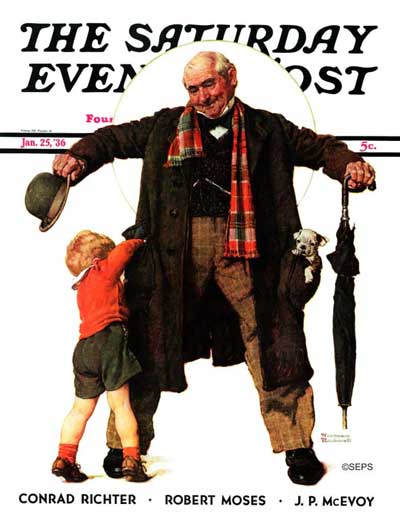
Norman Rockwell
January 25, 1936
Norman Rockwell’s Christmas paintings are some of his most charming and heartening. His connection to Christmas was deepened in his childhood by his Uncle Gil, an eccentric inventor and scientist. Uncle Gil would bring firecrackers at Christmas to celebrate the Fourth of July, Christmas presents on Easter, and chocolate rabbits on Thanksgiving. The next year he would turn things upside down again and bring chocolate rabbits hidden in his pockets for the children on Christmas. Uncle Gil was a character straight out of Charles Dickens [http://www.saturdayeveningpost.com/2015/12/09/art-entertainment/art-and-artists/rockwells-dickensian-series.html], the great storyteller that had such a profound influence on my grandfather and his work. And I think somehow Uncle Gil became the embodiment of the Christmas spirit and this always stayed with Pop. He painted his memory of Uncle Gil in Little Boy Reaching in Grandfather’s Overcoat for The Saturday Evening Post cover, January 25, 1936. The little boy is my father, Thomas.
Home for Christmas (or, Stockbridge Main Street at Christmas) was painted for McCall’s December 1967 issue. It is one of my favorites. The main street of Stockbridge today still looks much the same. The little secret of the painting is the house with black shutters on the far right with all the windows illuminated and smoke coming out of its chimney — that was my grandfather’s home, with his barn red studio next to it, where we spent every Thanksgiving and Christmas. I still dream of that house.
It is easy to get lost in the details of this painting. It is full of life, movement and Yuletide festivity: children playing, shoppers with packages rushing home, cars in transit, people going into the library. But it is the less noticeable details that have always captured my interest. Some windows have candles in them, others don’t but instead have their blinds drawn. Some cars are parked correctly; others are a bit askew, presumably because the snow has erased the lines. I love the visible car tracks in the snow and all the different makes and models of automobiles; the newest one of that Christmas looks a bit like the Volkswagen Beetle, the blue car just left of the darkened inn.
The Red Lion Inn was closed at this time because it had fallen into neglect after one owner, Robert Wheeler, had misguidedly attempted to refashion it as a “motor lodge.” His endeavor failed and the inn went dark, intended for demolition in 1968; a gas station was planned in its place. It was saved by the Fitzpatrick family who purchased the inn that same year; they have run it ever since. Stockbridge is a small town of tradition and neighborly kindness and community — it is what Pop loved about it. That, and the wonderful townspeople he found to paint.
My grandfather’s first studio in Stockbridge was in the building with the big plate glass window with the Christmas tree. It was his studio from 1953–1957. He had the picture window installed to get the north light. At the very far left of the painting is The Old Corner House, the original site of the Norman Rockwell Museum, the white colonial with porch windows.
Pop painted the landscape with a delicate, primitive feel, choosing to layer somber transparent tones of grays and browns. The sky is the perfect cold winter sky after the sun has quickly set. All of these bleak colors serve as a contrast to the brilliant yellow light of the bustling town and vibrant Christmas decorations. It is through this important sense of contrast that the meaning of the holiday season is quietly illuminated — finding the light at the peak of the darkest month.
Many holiday blessings to everyone for a wonderful Christmas and Hanukkah! May the light we find in this season carry us through this next year and usher in a time of increased kindness and peace — in spite of everything we are facing around the world right now.
Warmest wishes,
Abigail
P.S. I just gave the Norman Rockwell Museum Archives my finalized, detailed list of the numerous errors and omissions in the recent fraudulent biography of Norman Rockwell, American Mirror, published in 2013. As many of you know, it is because of this biography that I was compelled to start my “Rescuing Norman Rockwell” Facebook page. The extensive list is not just a refutation of falsifications based on my investigation of the primary sources — it presents a true portrait of my grandfather and his life, including many details and memories that I learned from my father, Thomas Rockwell, Pop’s middle son. It will serve as a guide for future Norman Rockwell biographers and scholars. I am happy that this page that started out as a fight to have the truth heard has ended up being a celebration of Norman Rockwell and his work.
Special thanks to Laura Claridge for her comprehensive research in her 2001 biography, Norman Rockwell, A Life. Her biography was a considerable help to me in my investigation.
Holiday Silliness
Comedy is often found in the unexpected, a contrast between the serious and the frivolous, the modern and the old fashioned. Or, it may be discovered in the all-too-familiar. Such as here – the more accurate account of the holiday season. Specifically for those of us who don’t wrap presents like mall workers, have a Christmas photo with everyone smiling and can’t make it through the tree-decorating process without dad throwing out his back.
All Wrapped Up in Christmas—Richard Sargent
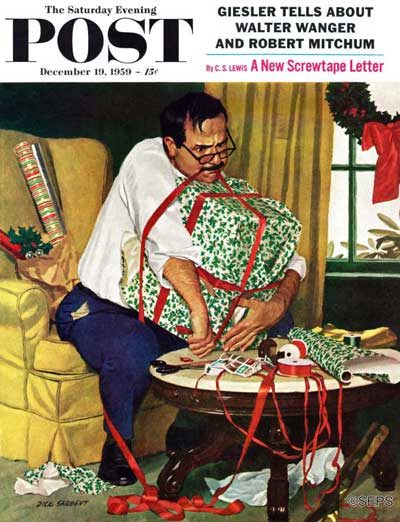
Richard Sargent
December 19, 1959
This dad is about to vanquished by his Christmas Eve wrapping project. Maybe he should have delegated this task to someone else…
Doggy Basket—Charles Kaiser
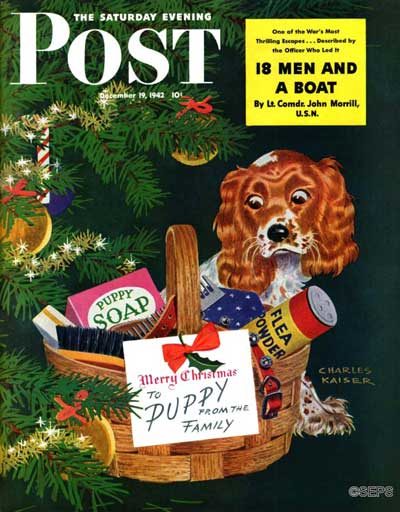
Charles Kaiser
December 19, 1942
Christmas, candy canes, and a puppy! There’s nothing not to love about this classic Post cover. Unless, of course you’re the dog who will be receiving a flee treatment and bath.
Santa’s Helper—Norman Rockwell
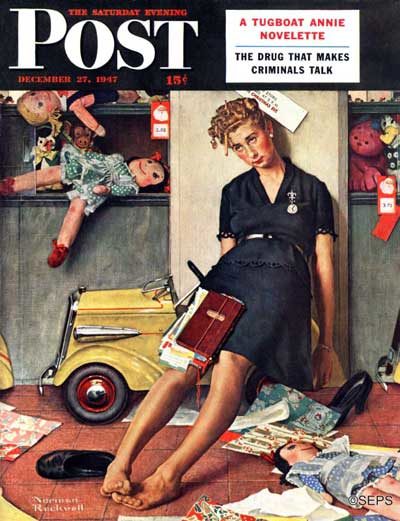
Norman Rockwell
December 27, 1947
This retail worker is done with the holiday season and, by the looks of it, so is the store. Instead of working in the studio for this cover, Norman Rockwell setup shop in Chicago’s Marshall Field’s department store. The store happily provided the setting and toys for the scene but Rockwell felt the picture needed more dolls so he went out and purchased a large number of them. He joked with the Post editors that he owned more dolls than any other 53-year-old kid.
Hidden Gifts—Constantin Alajalov
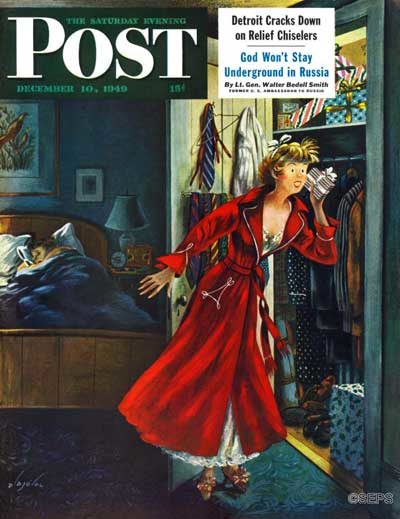
Constantin Alajalov
December 10, 1949
A cover revealing the difficulty even adults face when compelled to investigate their presents. Depicted by Russia-born artist Constantin Alajalov who specialized in illustrations gently pointing out human frailty. Though, it’s hard to fault this lady when the temptation lays less than five feet from her bed.
Trimming the Tree—George Hughes
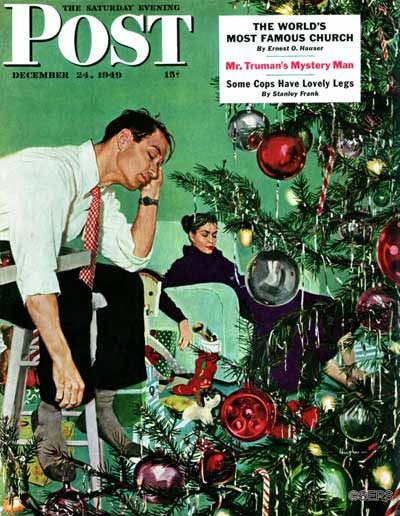
George Hughes
Can’t we all relate to the exhaustion after the Christmas decorating has ended? This man couldn’t even make it to a couch. In reality though, Hughes set the scene for this painting in June of 1949 after he ventured into the Vermont woods, chopped down a pine tree, took it home, and decked it with holiday cheer. He was forced to finish his work quickly, as the summer heat was causing the tree to drop needles and his 2-year-old daughter kept pulling off the ornaments.
Tree Love—Constantin Alajalov
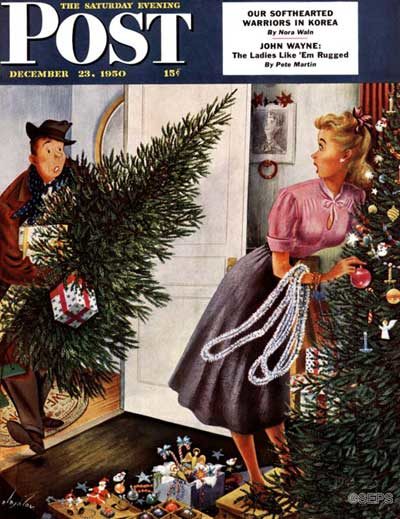
Constantin Alajalov
December 23, 1950
As if one tree wasn’t difficult enough! Alajalov’s art can often be located at the intersection of cartoonish and realistic. His ability to combine a fashionable, clean stlye with warm-hearted satire was not only perfect for the Post but also for The New Yorker. He is the only artist to work for both magazines (each normally demanded exclusivity).
Christmas Photograph—Amos Sewell
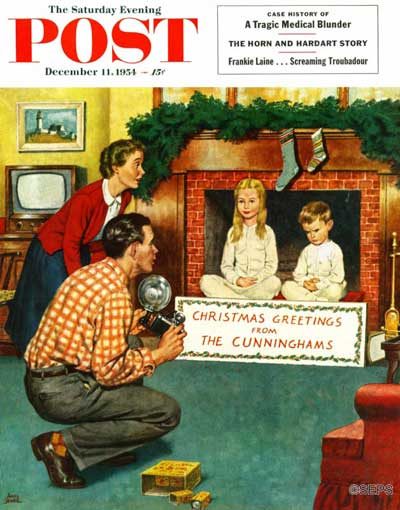
Amos Sewell
December 11, 1954
As the camera became ubiquitous, so did the family Christmas card. The only problem? Getting everyone to cooperate.
Topping the Tree—John Falter
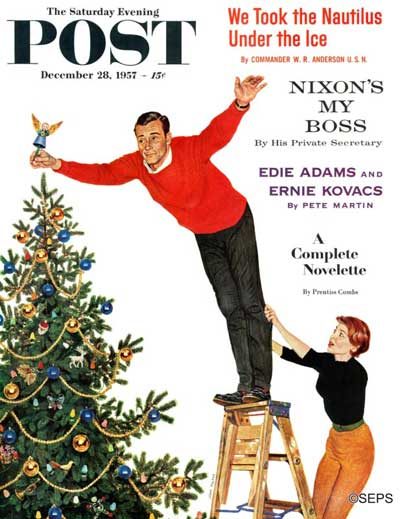
John Falter
December 28, 1957
Tipping point? Falter specialized in capturing the comedy in family life, often delivering a small, humorous moral. We’d proposed, for this one, the lesson: “Behind every holiday-decorating hero is a woman firmly holding him upright.”
Christmas Morning—Ben Kimberly Prins
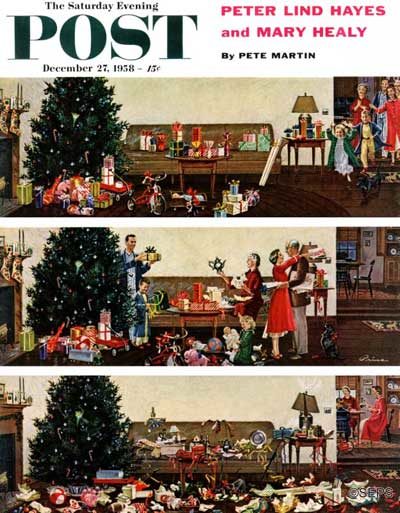
Ben Kimberly Prins
December 27, 1958
Prins artfully unveiled Christmas morning. This sweetly humorous illustration also has a wistful quality: All those weeks of preparation-the buying of gifts, the careful wrapping—then suddenly we’re left with a roomful of shredded paper.
Merry Christmas from the IRS—Ben Kimberly Prins
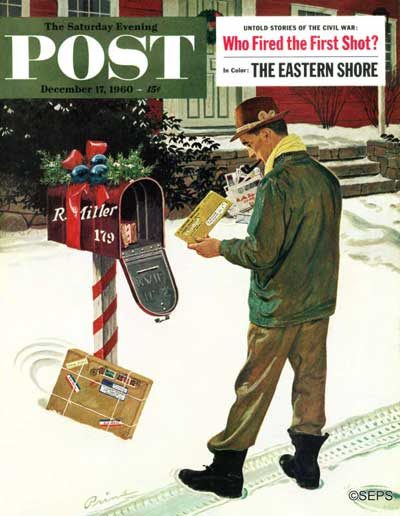
Ben Kimberly Prins
December 17, 1960
How nice to be remembered with cards and packages bursting from one’s cheerfully decorated mailbox! But Christmas might be ending early for this man after receiving a notice from the U.S. Treasury Department.
What I Want for Christmas

When I was in my mid-20s, I asked Santa for a house, but got a shirt instead. Apparently, Santa didn’t care what I wanted, so I stopped believing in him. I’ve become so cynical these past few years I’m starting to have doubts about the Easter Bunny, too.
So far the only one who’s delivered the goods is Old Man Winter. Last year, I asked him for lots of snow and the geezer came through. Our town got 55 inches of snow, instead of our usual 25. Of course, there’s no pleasing some people. You’d be amazed how upset some folks were, bellyaching about having to shovel a little snow. Like my wife, for instance, even though I had given her a new shovel for Christmas.
This year, I’m giving Santa the chance to redeem himself so have asked him for a white Christmas. There’s nothing worse than waking up on Christmas morning and seeing dead brown grass instead of snow. Well, maybe cancer is worse, but just barely. It depends on the kind of cancer. I had skin cancer last year and not having snow for Christmas was definitely worse than my skin cancer, which the doctor fixed in five minutes. Yes, I’m a cancer survivor, but I prefer not to talk about it. No sense getting people all depressed.
Where was I? Oh, yes, snow for Christmas. Twelve inches, please. I’m a pastor and have to work on Christmas Eve, so if the snow could start falling in the late afternoon of the 24th and get me a day off work, that would be even better. Then I’d apologize to Santa Claus for ever doubting him. Twelve inches of snow, then a cold snap so it won’t melt for at least two months. Thirty, maybe 40 below zero, so it would be too cold for school and my wife could stay home and carry in firewood for our woodstove. Thanks to me, she’s in tremendous shape for a woman in her 50s.
As wonderful as snow is, it’s odd that it leads to the worst thing ever, which is slush. Slush is even worse than dead brown grass at Christmas. Dead brown grass doesn’t spill over the tops of your shoes and soak your socks.
The best thing about snow is the stillness. I guess what I’m really asking Santa for is peace and quiet. When it snows people stay home, except for our town’s snowplow driver, Ray Whitaker, who passes by in the moon hours, his amber strobe casting shadows across our bedroom wall. We live on the north edge of town, the Welcome to Danville sign is in our side yard. Ray plows the street up to the sign, then puts his truck in reverse. I can hear the beeper on his truck as he backs up a half block, turns around, and heads into town.
For the 14 years my dad served on the town board, he took doughnuts to Ray the morning after every snowfall, but would always bring one home to me. Whenever it snows, I think of doughnuts. Dad no longer drives, so now I’m the doughnut man. Ray has the streets clear by 6 a.m., so I drive to Kroger, buy a box of doughnuts, and take them to Ray, who is at the town garage, brushing the snow off his truck before pulling it into the bay. If it snows on Christmas Eve this year, Ray will have to do without doughnuts since Kroger is closed on Christmas morning. My wife will make him blueberry coffee cake instead.
Ray complains whenever it snows, but it’s all a show. Like most men, he loves an adventure, and there are few things as exciting as being out in a heavy snow. Sometimes I’ll even take Ray doughnuts before the streets are cleared, just for the thrill of it. There are three hills between our house and town, so I have to get a good head of steam up before hitting each hill. Even so, my tires spin, as does my mind, to silent winters past.
The 12 Blessings of Christmas

Church Christmas Tree
Stevan Dohanos
December 27, 1952
Grateful for the studded snow tires that anchor my car to the frozen earth, I follow the old dirt road as it crosses an icy creek, then winds through the snowy woods that extend for miles through the Vermont mountains.
It’s an incredibly beautiful day. Spotting the simple, 200-year-old Quaker meetinghouse in a sunny clearing ahead, I carefully slow to pull off the road, then stop by the freshly plowed path to its door.
To the north, there’s the sound of wood being chopped. To the east, a dog barks. But here there is only silence. As it has for nearly two centuries, this simple country church sits in a profound stillness rich with a sense of Presence. Leaning back in the sun, I relax for the first time in weeks.
This is my favorite time of year. My car is loaded with freshly cut pine boughs, candles, baskets of pine cones, dried seed pods, and lemon balm, plus garlands of balsam that I’ll use to drape over the door and decorate the deep windowsills of the old meetinghouse. But as I sit here in the warm sun, the rich fragrances of woods and meadow hold me in my seat—and remind me of the joyful blessings that will be woven into my life over the next several weeks.
1. The Blessing of Community
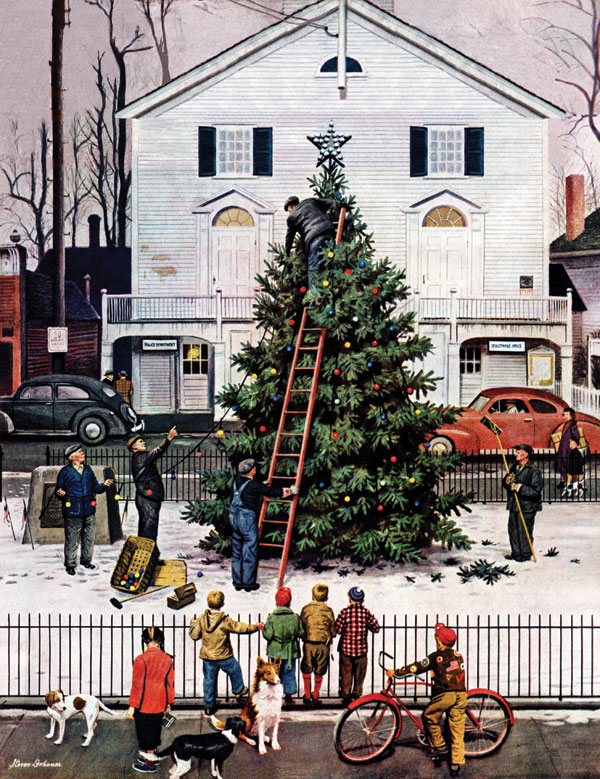
Tree in Town Square
Stevan Dohanos
December 4, 1948
During the holiday season, the entire world seems in harmony: Christians celebrate the birth of Jesus, Buddhists remember the enlightenment of Siddhartha, Jews recall the miraculous temple lamp that burned for eight days, Muslims welcome the new year based on the lunar calendar, and even nontheists join the expression of goodwill with colored lights and electric Santas that wave to passersby.
Down the mountain in the village of Bristol, the Christmas season begins on the first Saturday of December when villagers sweep the snow from their steps, light the village Christmas tree, and members of three churches around the village green hold their annual Christmas Bazaars.
“It looks like an old-fashioned Christmas card,” chuckles my friend Laurie Kroll. “Wreaths and greens are everywhere. St. Ambrose has a silver tea on one side of the green, First Baptist has soups and sandwiches for lunch on the other side, and the Federated Church around the corner has Santa.”
The members of each church have been knitting and baking for weeks to produce an abundance of foods and crafts, and each church becomes a small marketplace with tables of homemade jams and pickles, knitted hats, fruit-studded braided breads, and every kind of holiday ornament imaginable. It’s a fundraiser, sure—”One year we made enough to buy a new vacuum,” Laurie remembers—but more than that, it’s a time of coming together and remembering what we share.
2. The Blessing of Giving
Thinking about my friends in Bristol, I realize that there are probably few of us who won’t admit that gift-giving has strayed far from its humble beginnings of homemade crafts and food—particularly when we have to cart piles of wrapping paper and plastic packaging to the recycling center after Christmas or pay our credit card bills in January.
A few years ago, this really got to ecology author and activist Bill McKibben, who lives a few hills over from me near Ripton. “A bunch of us in what was then the Troy conference of the Methodist Church, were thinking that there was a lot of waste at Christmastime—all those batteries!” Bill recently messaged me. “But when we started talking with folks about new ways of celebrating Xmas, we quickly found out that there was something deeper here. People really dreaded the approach of Christmas, because it had all become too much—and they were incredibly receptive to the idea of doing it differently, with an emphasis on gifts of service.”
Bill and his friends persuaded a number of families to commit themselves to doing things for those with whom they normally exchanged gifts—walking an elderly aunt’s dog when the temperature drops into the single digits, for example. Bill subsequently wrote a book called Hundred Dollar Holiday, in which he proposed spending no more than $100 per family at Christmas. The result? Less running back and forth to the mall, less time spent desperately looking for hot toys and sales, less time tuned out with electronics—and more time spent sitting by the fire with family, sharing a potluck with friends, or taking a long walk outside, alone in the freshly fallen snow.
Best Christmas Movies Ever
The results are in! The Post staff picks the best Christmas movies and TV specials of all time.
10.) A Christmas Carol
Charles Dickens’ 1843 novella is possibly the most enduring and familiar Christmas story of all time. It has been adapted for TV and film hundreds of times, including the latest 3D animated version released by Disney this year. Collectively, they are all our number-ten pick. Some of our favorites include Scrooge (1951), Scrooged (1988), starring Bill Murray, and Mickey’s Christmas Carol (1983) (TV), starring Scrooge McDuck as Ebeneezer, of course. Two we could do without, both from the late 1990s, are Patrick Stewart’s A Christmas Carol (1999) (TV) and Ms. Scrooge (1997) (TV), starring Cicely Tyson as “Ms. Ebenita” Scrooge.
9.) Love, Actually (2003)
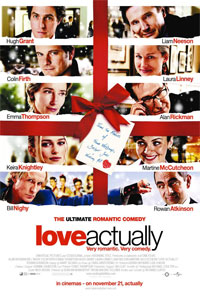 The most modern movie to make our list, Love, Actually, was an unexpected surprise. The British romantic comedy weaves together a number of love affairs into one well-wrapped holiday package. Sure to spark a dialogue among its viewers, as it did with our staff, this hip Christmas movie is actually loved.
The most modern movie to make our list, Love, Actually, was an unexpected surprise. The British romantic comedy weaves together a number of love affairs into one well-wrapped holiday package. Sure to spark a dialogue among its viewers, as it did with our staff, this hip Christmas movie is actually loved.
8.) Rudolph, the Red-Nosed Reindeer (1964) (TV)
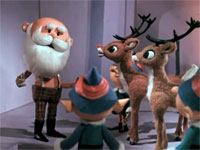 Developed in 1939 by Robert May for the department store Montgomery Ward, Rudolph remains one of the most recognizable Christmas characters. It’s hard to not feel sympathetic toward the lovable, red-nosed quadruped, and it’s nice to know that even he has a place at Christmas.
Developed in 1939 by Robert May for the department store Montgomery Ward, Rudolph remains one of the most recognizable Christmas characters. It’s hard to not feel sympathetic toward the lovable, red-nosed quadruped, and it’s nice to know that even he has a place at Christmas.
7.) How the Grinch Stole Christmas! (1966) (TV)
The Grinch is the most famous holiday villain, and Chuck Jones’ 1966 cartoon is Seussean to a degree the big-budget, live-action Christmas movie just couldn’t achieve. Christmas isn’t Christmas without Cindy Lou, roast beast, and this TV classic, and we’d all do well to see our own hearts grow three sizes in a day.
6.) White Christmas (1954)
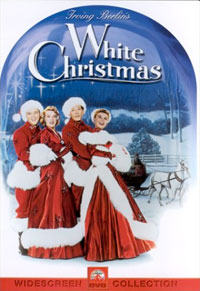 Irving Berlin’s White Christmas, starring Bing Crosby and Danny Kaye, is the lone musical to make our list. The popular song by the same title actually first arrived on the American scene in 1941 when Crosby performed the song on his popular NBC radio show, The Kraft Music Hall. The rest, as they say, is history. In 1942, the song was released as part of an album from the film Holiday Inn. In 1954, White Christmas, the film, was released, building on the song’s popularity, which subsequently became the top selling record of all time, selling more than 50 million copies.
Irving Berlin’s White Christmas, starring Bing Crosby and Danny Kaye, is the lone musical to make our list. The popular song by the same title actually first arrived on the American scene in 1941 when Crosby performed the song on his popular NBC radio show, The Kraft Music Hall. The rest, as they say, is history. In 1942, the song was released as part of an album from the film Holiday Inn. In 1954, White Christmas, the film, was released, building on the song’s popularity, which subsequently became the top selling record of all time, selling more than 50 million copies.